After shedding light on the intricate visual effects of Black Panther: Wakanda Forever in 2023, Geoffrey Baumann is back to delve into his latest project, Ghostbusters: Frozen Empire, offering a glimpse into the creative process behind the scenes.
How did you get involved on this movie?
Lori Furie at SPE reached out to me to see if I would be interested in working on Ghostbusters. Working in VFX for 25 years and a child of the 70s and 80s how could I say no to such an opportunity. I of course said yes and that led to a meeting with Director Gil Kenan.
What was your feeling to be part of the Ghostbusters universe?
What an honor. I remember going to the theater in Zurich in 1984 when I was a kid and seeing this with my friends and being blown away. What was this magic?! Without realizing it then I think this pushed me into film making and Visual Effects.
How was this new collaboration Director Gil Kenan?
Gil is an amazing collaborator! He has a vision and is very clear about what he wants and always open to ideas but knows when he likes or for that matter doesn’t like something. This encompasses all disciplines of film making and there by creates an environment where all involved collaborate. Gil also has a lot of experience with animation and VFX so he understands the complexity of his notes and the timeline we are working to. This is a great attribute to have as a Director, understanding how something is rigged or textured helps dramatically in his ability to give good direction.
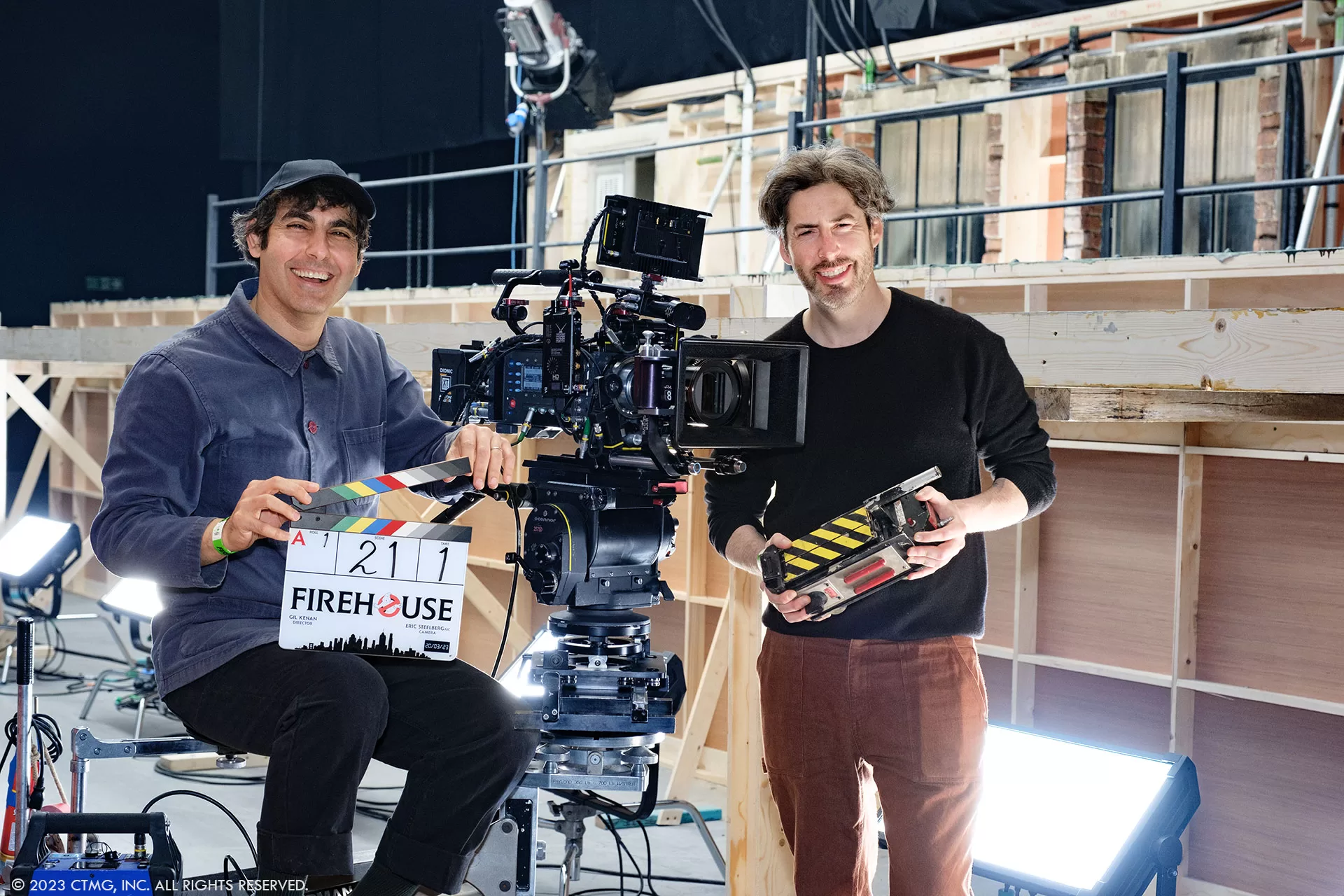
How did you organize the work with your VFX Producer?
The entire show was taken on by Sony Pictures Imageworks (SPI), under the Supervision of Jason Greenblum and Senior VFX Producer John Clinton. My partner on the production side of this adventure was Nicole Rowley, VFX Producer. Nicole and I helped Jason and John manage schedule and development. With the large number of shots, tight schedule, and complexity of the work we needed to be in lock step with SPI to hit our delivery and have a successful DI. SPI was extremely welcoming to us and allowing us to be part of their internal process. Territory Studio in London helped us with all our motion graphics and screens. Studio AKA in London was responsible for the animated sequence that plays in the basement of the library. We carved out just over 100 shots of overflow in the last two months for Barnstorm VFX and DNEG.
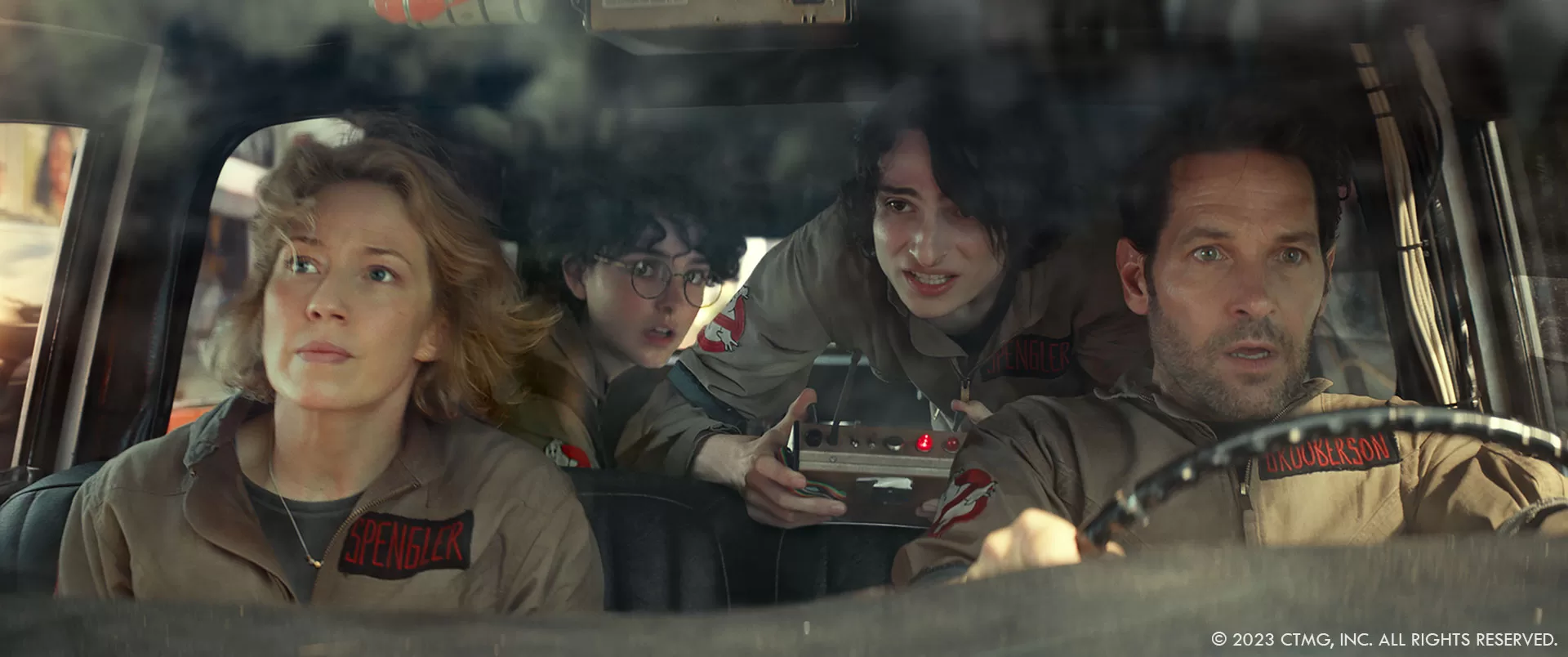
How did you choose the various vendors and split the work amongst them?
There was a strong desire to keep the work under the umbrella of Sony, Columbia, and Nicole and I worked hard to make this work. Although we both are generally uncomfortable with putting so many eggs in one basket so to speak. SPI stepped up and fully committed to the show on all fronts, character animation, CG characters, and FX. The show had it all. DNEG came in to assist on some of the 3rd act additional photography Mini Puft scenes as they already had a base knowledge having worked on Afterlife.
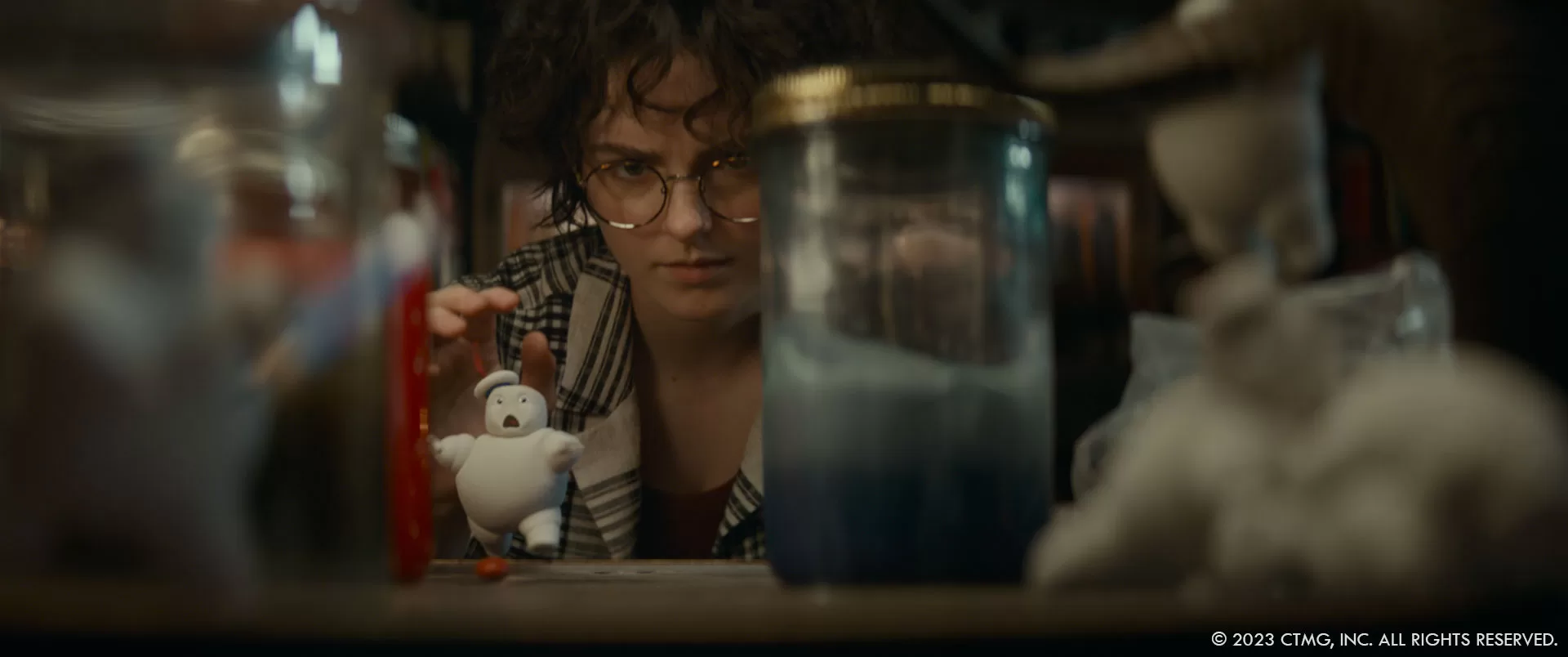
What is the your role on set and how do you work with other departments?
On set my role is to be as proactive and collaborative as possible, seeing through the methodologies agreed upon in pre-production and flagging any issues that have come up on the day. This means lots of checking in with all the other HODs so we are all clear on where the hand off will be from practical FX or sets to VFX. This film was unique in today’s film making process in that there was a lot of practical work done. From in camera puppets, Slimer, Library Ghost, a pizza, to remote controlled vacuums and tricycles, these all played as shot, with a hand off to CG only when necessary. In addition to these aspects, I work closely with the DOP to make sure the aesthetic and look of the film stays consistent to what the DOP had envisioned all the way through to the DI.
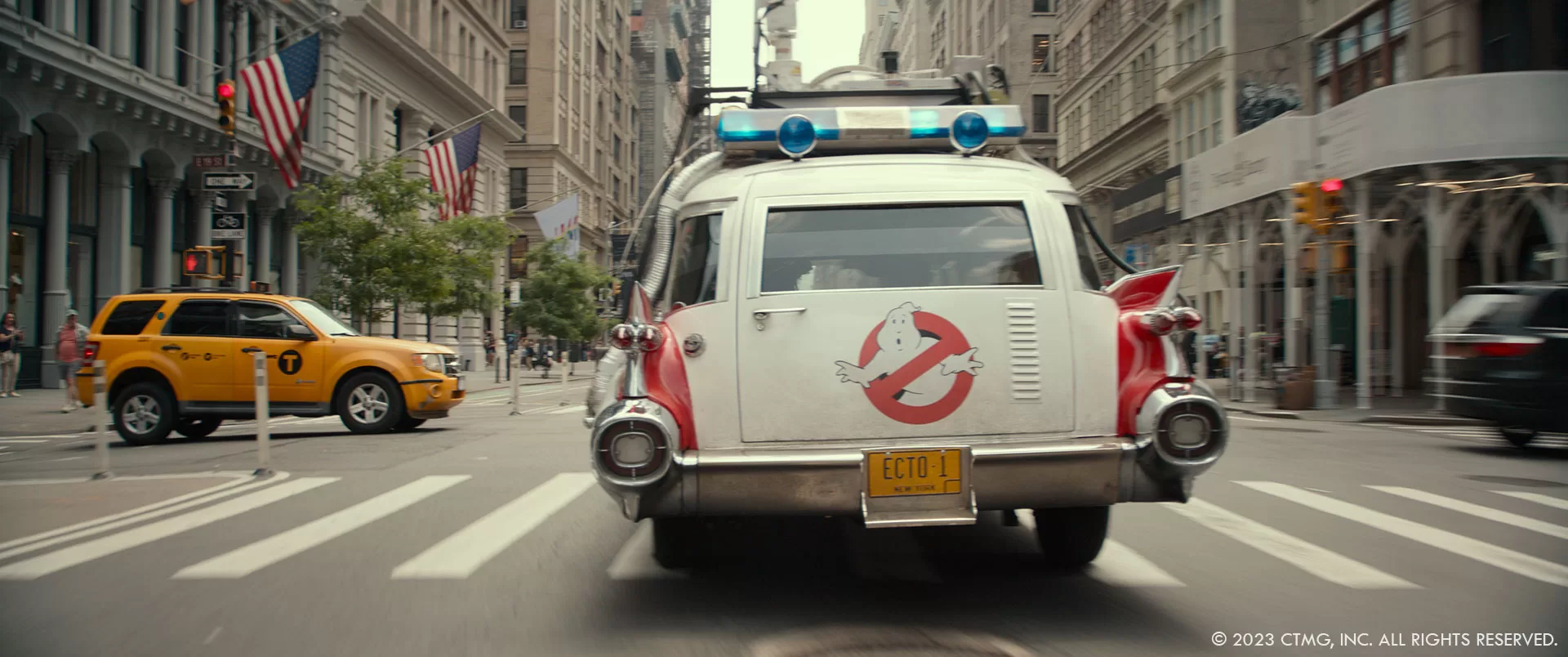
Could you provide insights into the technical challenges faced during the filming of the New York City chase scene between the Ghostbusters and the sewer dragon?
The biggest challenge of the New York shoot was shooting in New York and finding ways to work within the cities constraints while still acquiring the material we needed. Mother nature acted up as well and we were shut down by poor air quality due to forest fires in north eastern Canada. Shooting wise the big challenges are finding ways to make the 2-3 city blocks we had at our locations appear long enough to cover the action without too much overlap. Another challenge was the drone shoot for the sequence, which was picked up in October 2023. NYC had just changed the drone permit process to allow for drone shoots in the city. We were the first production to officially shoot permitted drone plates in NYC, and I think the plates we shot really stand out visually as well as help the story.
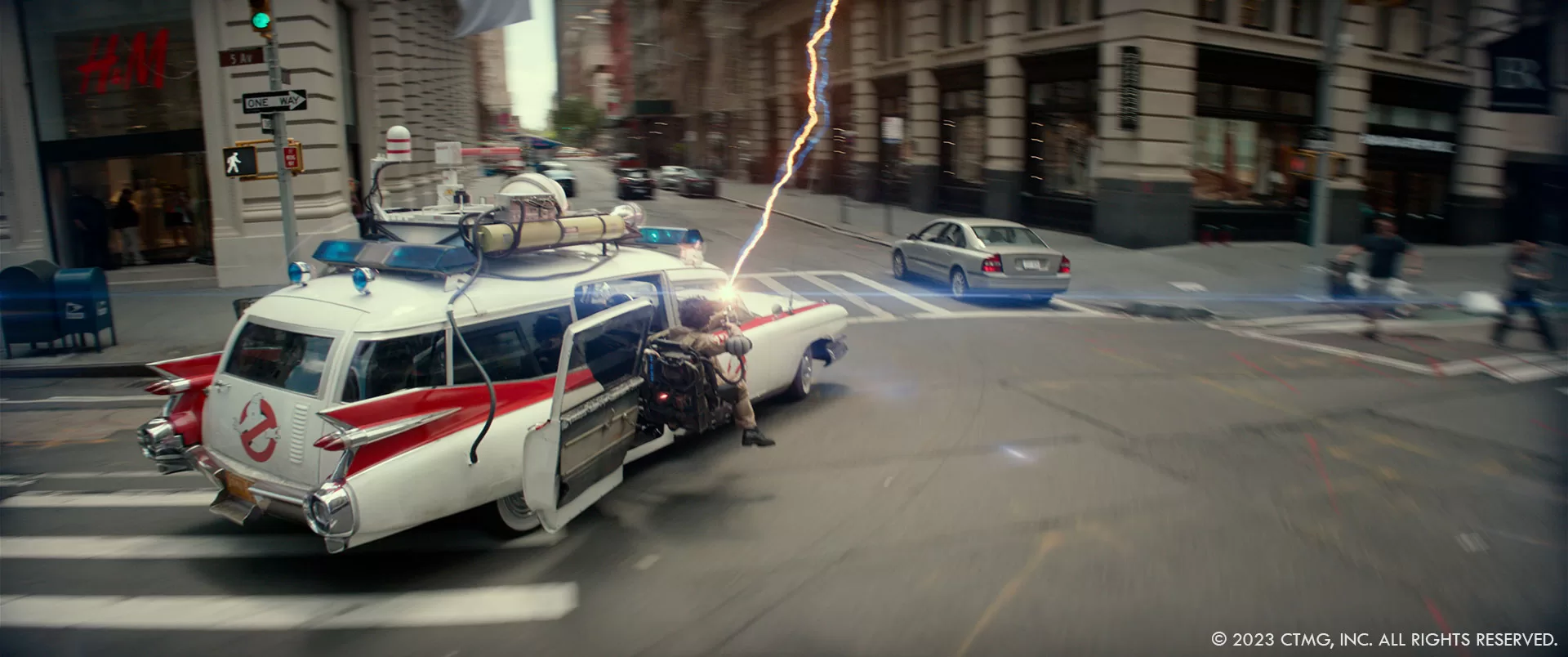
Can you elaborates about the design and the creation of the sewer dragon?
The Sewer Dragon’s early design and exploration was done by DNEG. Once Gil was happy with this conceptually SPI took over and brought the character to life. We first designed the Sewer Dragon to be fully opaque with skin and scales. We felt it was important to design something that was ‘photographic’ and real before moving towards the ghost look. Once this look was approved, we moved into the ghost world. We referenced the 1984 subway ghost for look and then explored color, transparency, and smoke density. Plate lighting and background color, buildings vs sky, all became factors once we began to introduce transparency. The color of the Sewer Dragon would shift depending on the values of the BG. Comp had to compensate for this to try and keep the look of the Dragon consistent.
How did you handle the animation challenges of the dragon?
Animation on the film was led by Troy Saliba, our Animation Supervisor. He had collaborated with Gil and the past and is an amazing traditional animator himself. Gil did not want the Dragon to look like an eel swimming through the water. Troy and the team, under Craig McPherson Animation Supervisor at SPI, designed to characters motion to be fleeting, darting left and right while still trying to have substantial weight.
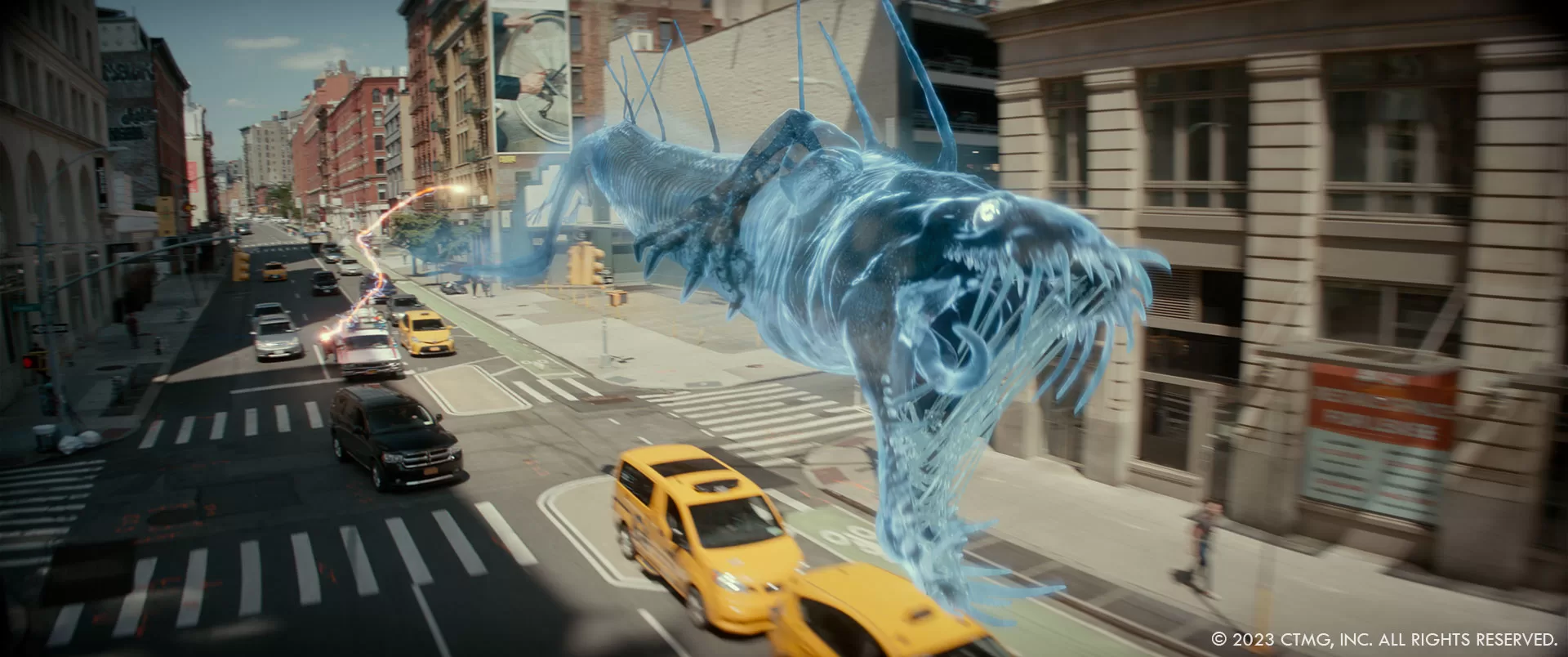
Can you elaborate on the collaborative process between the special effects team and your VFX team with the car chase?
SFX worked closely with VFX throughout the project, but for the car chase they focused more on the Ecto1 mechanical effects and RTV and Drone. The gunners seat was a working door. The RTV was a practical and the bay door in the Ecto1 was practical. Once in the street, the RTV was CG. The Drone was working practical prop as well, but it was CG flying through the city, lifting up off of Ecto1. The final crash into the bike stand was a mechanical gag with VFX cleaning up the hydraulic lines used to launch them into the air. SFX also built a motion base for the Ecto1 process work.
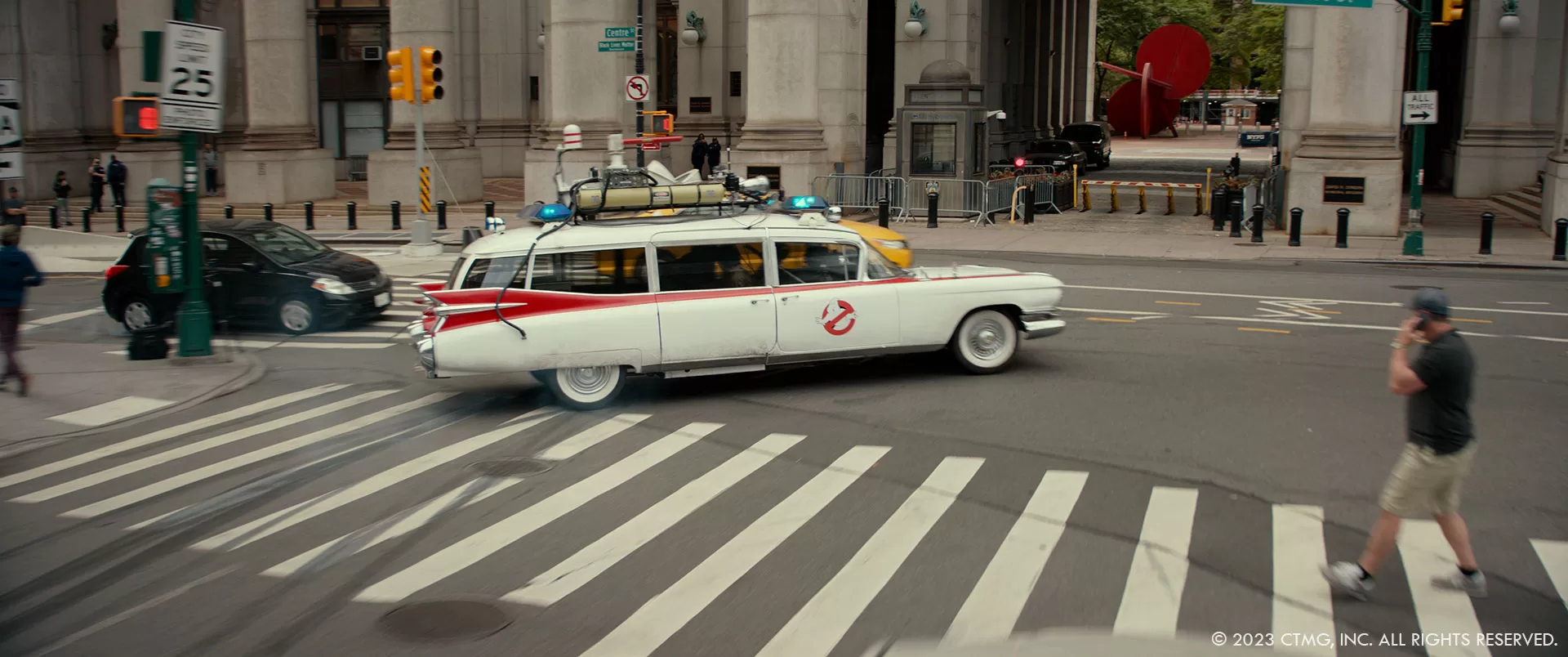
What was the main challenges with this car chase?
I would say this biggest challenge of the car chase was keeping the Sewer Dragon’s look and smoke density consistent, as we dialed in the elements in comp. As mentioned above the BG values and colors effected the look as the character was transparent. The further away the Dragon was the less apparent the smoke and densities would become so it we would often compensate for this. These continual adjustments made it a challenge to keep the flow and look of the sequence consistent.
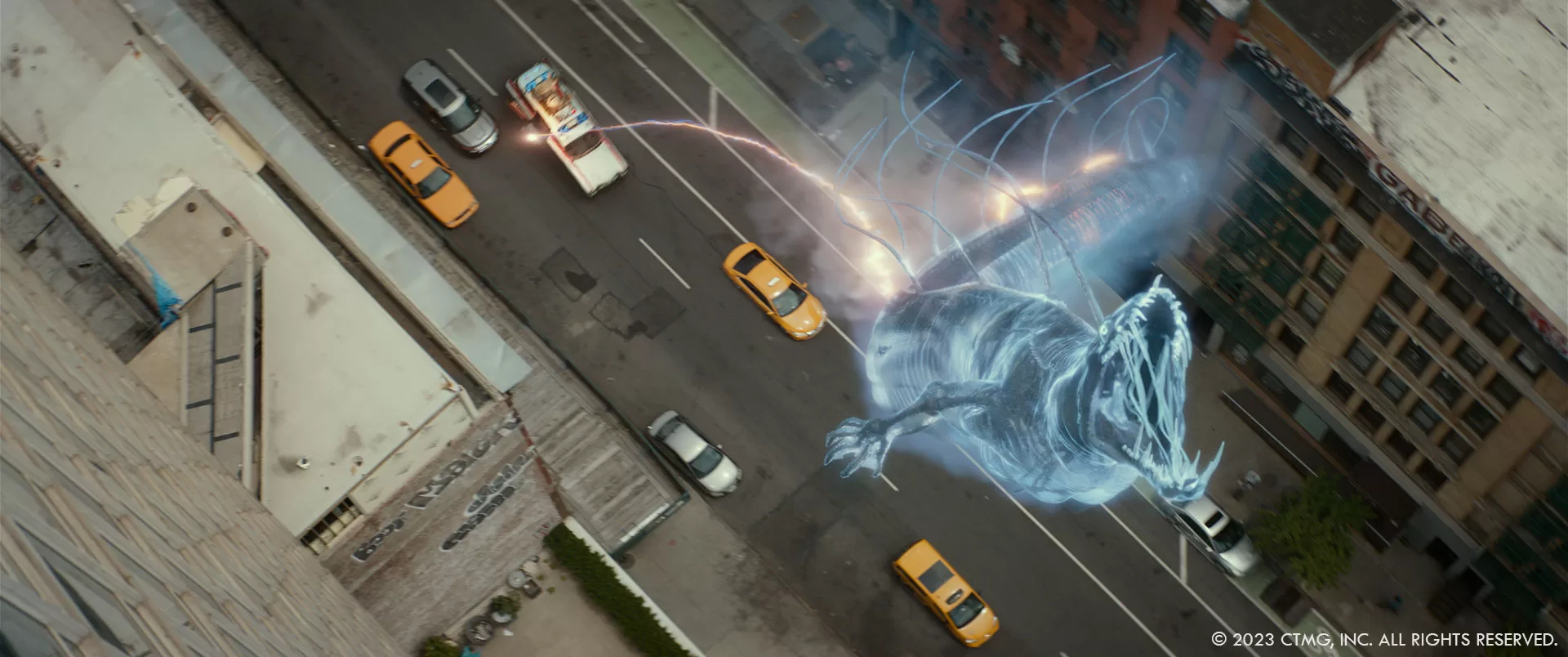
Could you walk us through the creative process behind bringing Slimer back to the big screen?
From Day 1 Gil wanted Slimer to be practical. Or creature FX team led by Arjen Tuiten, built a puppet based off the 1984 puppet. The look and movement and range of motion needed to not break this esthetic. Every shot in the film was either shot with the Slimer on set, in ‘situ’ or had a bespoke blue screen element shot for it. The puppet was scanned textured and put through a series of of motion tests. Although intended to be fully practical we knew there would be cleanup as well as a potential need for a CG Slimer. SPI began building the asset and matching the referenced look and range of motion. Gil used the puppet performance to cut with and select elements for SPI. As the edit and shot requirements evolved, we ended up creating a CG Slimer for every shot rotomating the performance to give us the ability to replace hands/arms or help with Cheeto interactions, and on occasion replacing the entire puppet if the shot required. This needed to be seamless, and Gil would always reference the approved puppet performance before approving any animation. We analyzed all Slimer scenes from 1984 with Gil and realized there were some discrepancies with regards to glow, transparency, and overall look. We started exploring these differences in the first scene we meet Slimer with Trevor, in the attic of the Firehouse. The background values and colors here influenced Slimers looks. Over darker backgrounds Slimer appeared more opaque and his color would appear more saturated or shift depending on these of the Background as well. This meant each one need it’s own special treatment keeping the character consistent within the scene as well as staying within the aesthetic established in 1984.
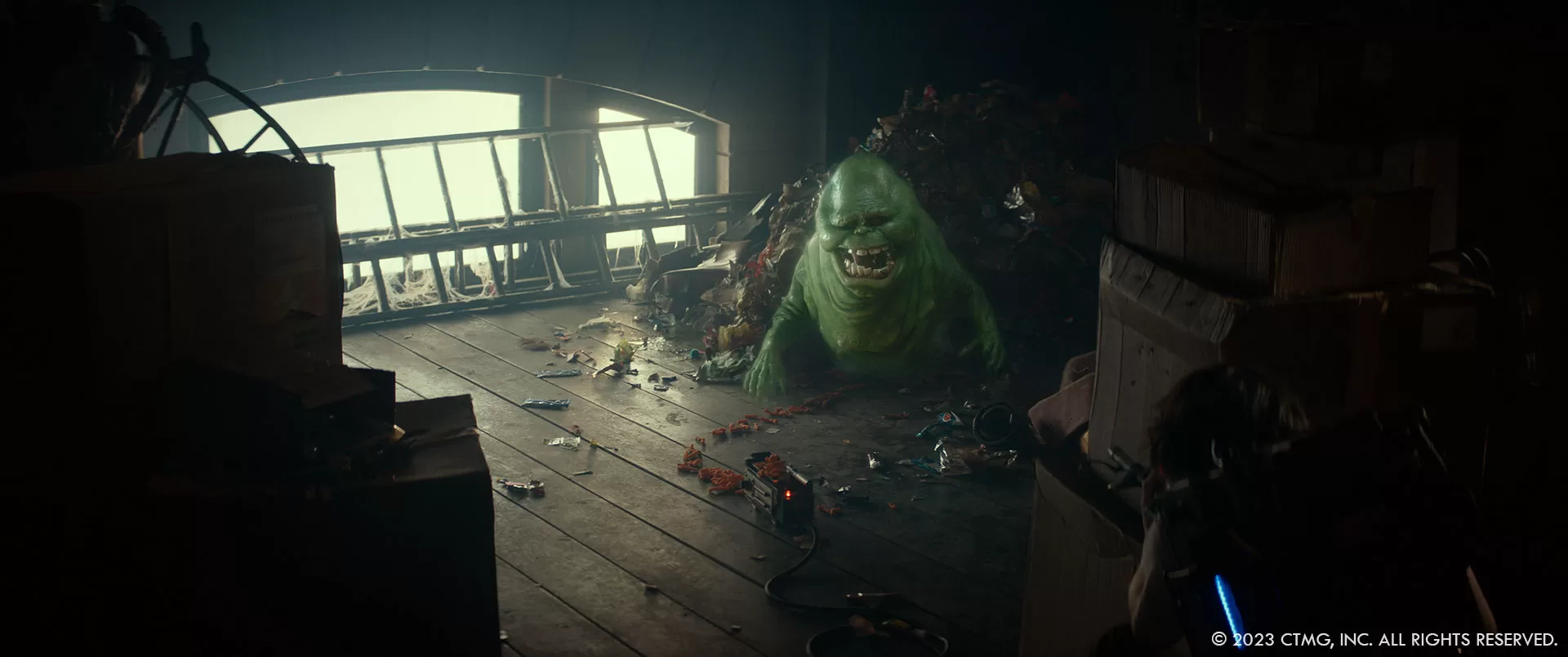
What were some of the key considerations in updating this iconic character from the previous movies?
The key consideration to updating Slimer was to try and stay true to the expectation fans have of based off Ghostbusters 1984.
What were some of the challenges faced by the design and animation teams with Slimer?
The design challenges such as how the jaw moves, or limited motion of the puppet are characteristics of the 1984 character. Camera would push in onto the puppet to represent Slimer traveling towards us or pull away if Slimer was flying away from us. We needed to embrace the design as they had done in 1984.
Could you elaborate on the inspiration behind the design and creation of the villain Garraka?
Garraka the villain in our film needed to be blend of creature creation from the 1980s and that of a fully CG character from today. This meant first working with concept artists to design the look of Garraka with Gil. He had a clear vision in his head as to what this character looked and moved like. After concepts were approved, we started looking at animation going back to Ray Harryhausen’s Jason and the Argonauts, and characters in horror films such as Pan’s Labyrinth. Looking specifically at motion and uncomfortable body shapes create characters. The textures of Garraka were designed to replicate silicone and materials that would have been used to create an animatronic version of the character. Once look was approved it was up to Troy Saliba again to find the balance of motion and reality that Gil was looking for. Gil did not want Garraka to be over animated, so movements were generally toned down and muscle sims were based off how a Garraka puppet would have been built rather than matching human anatomy.
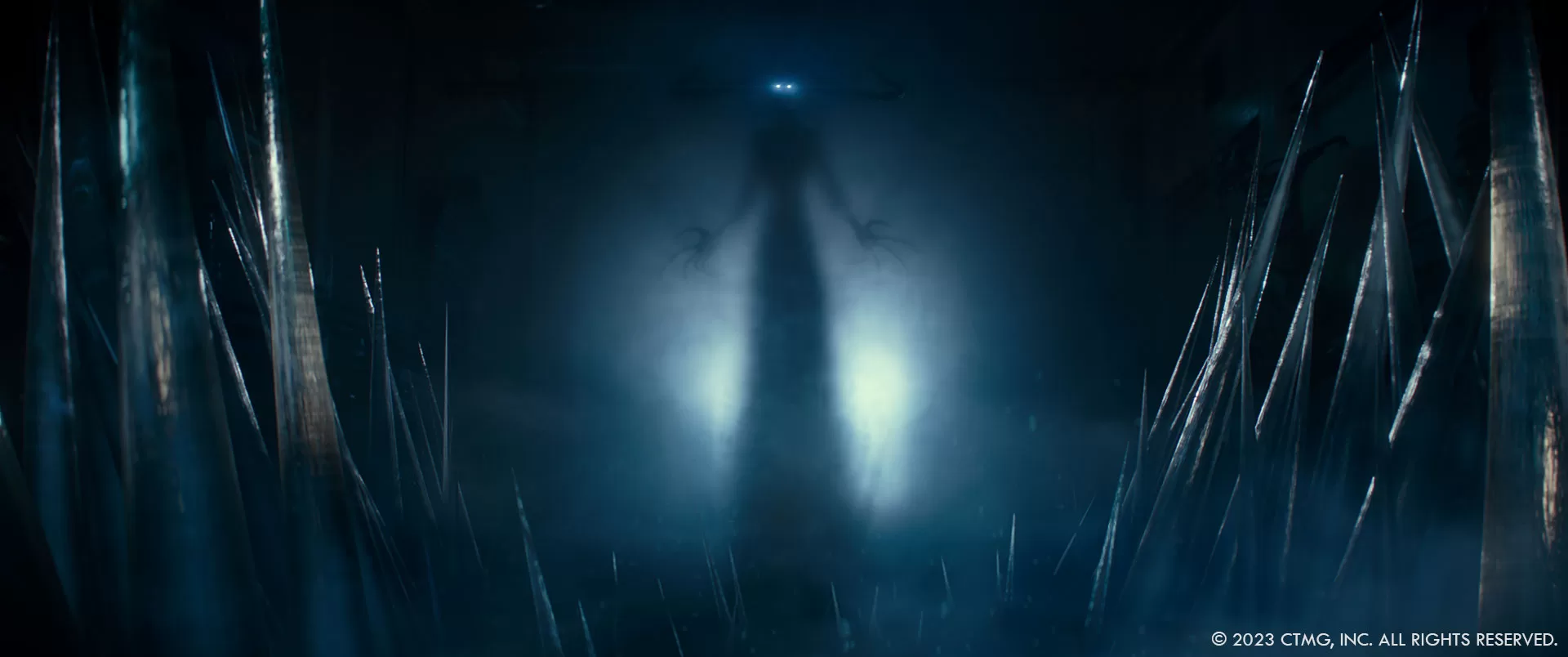
Did you mix practical and VFX for Garraka?
Unfortunately, there was no in camera Garraka. We did have a 3D printed head with LED eyes that was used for framing, but schedule did not allow for the creation of a full build of Garraka. Costumes did however source materials for his skirt so we could match the look and movement of that.
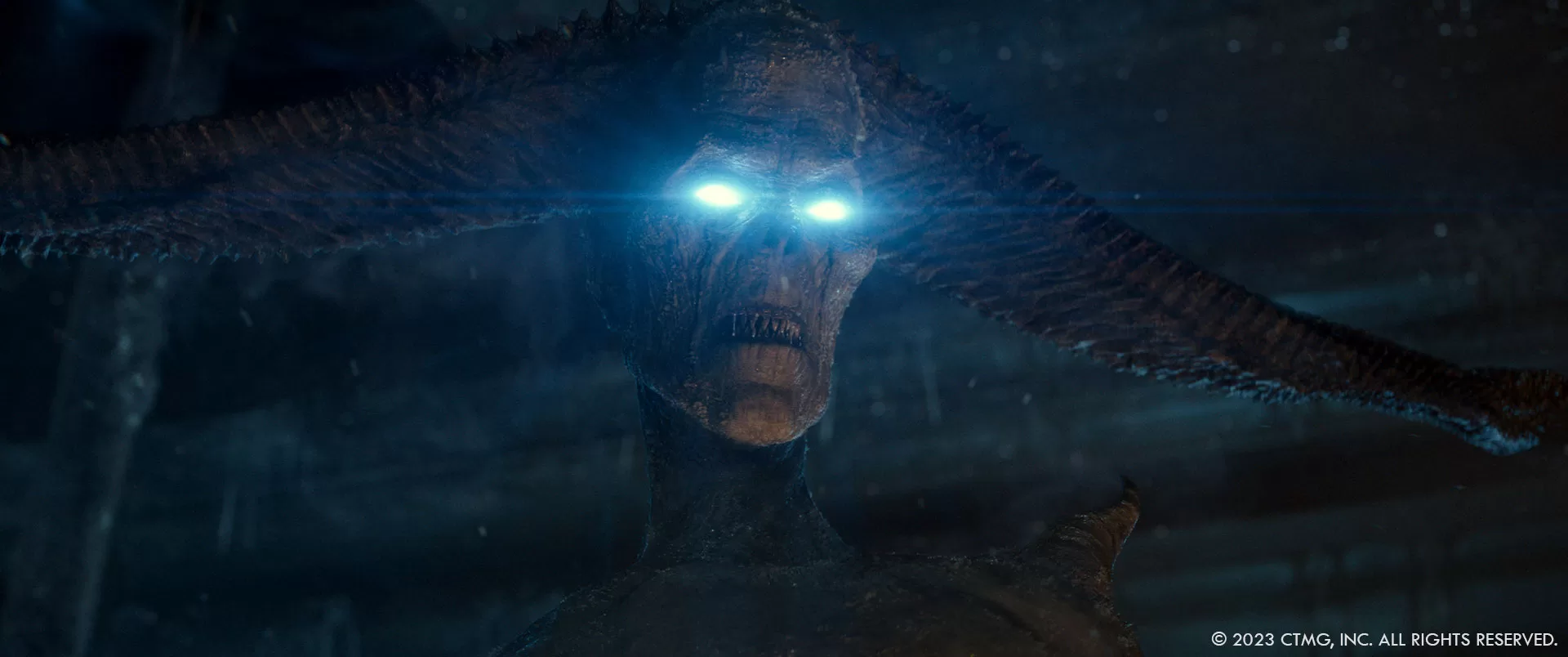
How did you approach creating a character that embodies the essence of menace while fitting within the established universe of Ghostbusters?
I think this came from Gil’s direction to keep thinking of Garraka as a practical build. How would a real puppet move? What would be the limitations of not just movement but also skin texture regarding subsurface qualities.
What were some of the key challenges encountered during the animation process, and how were they overcome?
I believe the biggest challenge was to get inside Gil’s head with regards to what type of motion he wanted. He had a very specific vision in his head for each character. With Gil’s background in animation, he is very knowledgeable with regards to the process from traditional to key frame to motion capture. Gil also wanted some characters, such as Garraka, to appear driven by servos and puppeteers. Troy who had worked with Gil in the past had an established shorthand with him, which became invaluable during the animation process. Troy would hand draw poses over plates for Gil to play with in the cut. This created a road map for Troy to work with SPI. The baggie sequence in the library for example troy hand drew baggies animation for the entire sequence with key frames throughout that explained how the character moved.
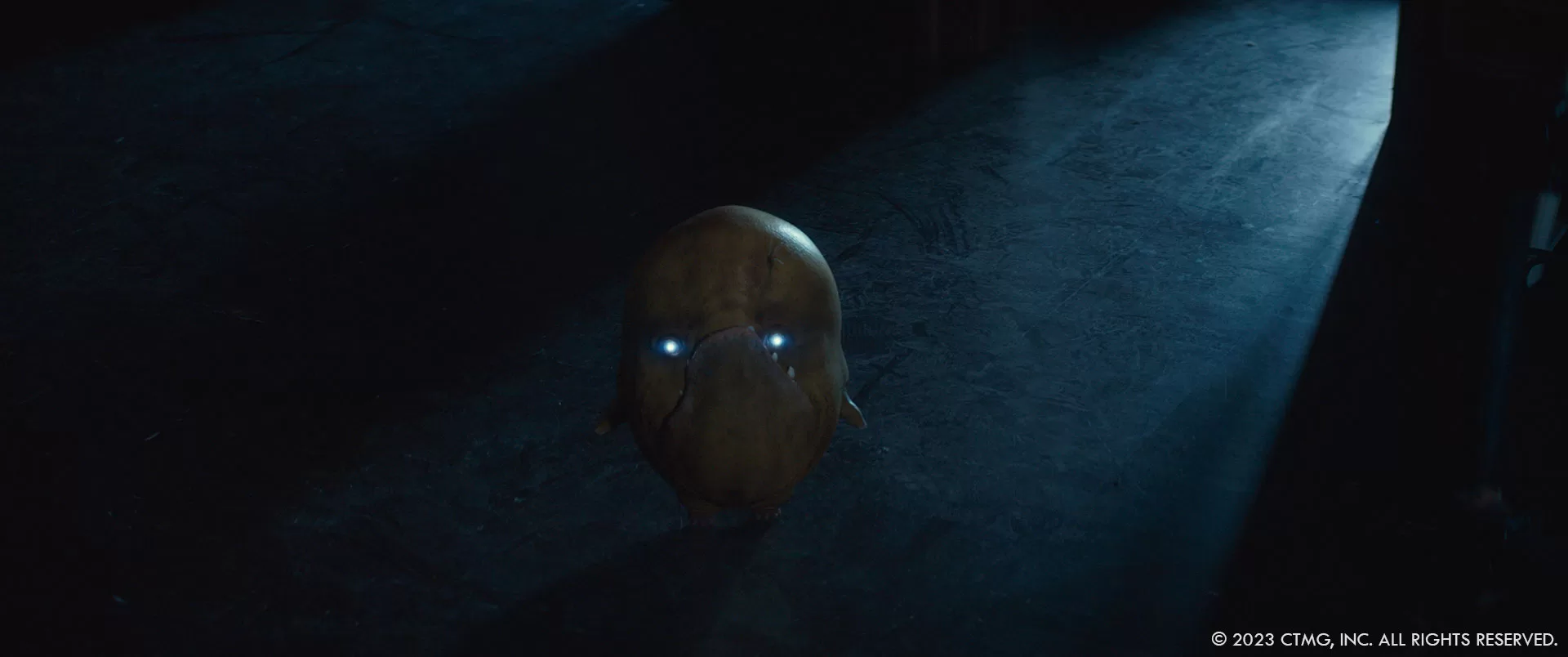
Could you elaborate on the technical challenges faced in creating and animating the ice effects engulfing characters and environments, and how your team tackled these challenges?
The ice covering our characters was based off the final look created by costumes and makeup. We needed create the transition from pre to frozen. This was then supported by SFX wind on the actors and the addition of CG frosty wind and snow. The challenge here was to not push the frost effects on our characters too much and allow the practical costumes and set dressing to do the heavy lifting.
What artistic and technical considerations went into making the ice effects visually convincing particularly in scenes where characters and environments are overtaken by ice?
The look and movement of the ice were the biggest creative challenges we needed to explore when creating Summer Storm. We referenced ice covered environments in Quebec as well as other areas where humanmade structures are covered in ice during winter months. Handrails, bus stops, wharfs etc. . . This gave us a base in reality regarding look. From here we dialed in the transparency and specularity to Gil’s taste. The movement of the ice presented another challenge. We began by referencing time-lapse photography of things freezing over and initially started off with the ice and ice spears moving in a staccato fashion in bursts but shifted back towards a more fluid smooth motion at the end of the day. Both motion and look were also greatly influenced by scale. We found that the same approach to a tight shot of ice crawling across a door did not translate to ice crawling across the Wonder Wheel in Coney Island.
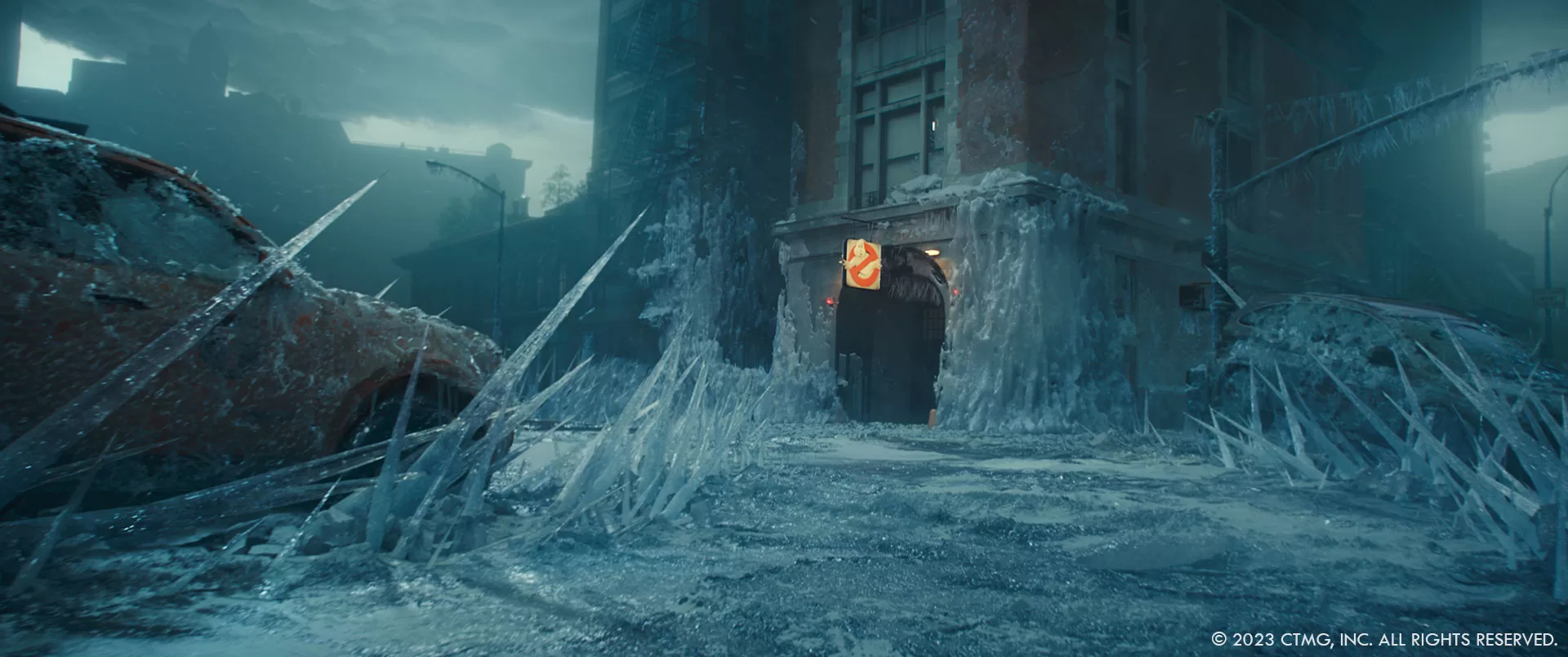
Were there any memorable moments or scenes from the film that you found particularly rewarding or challenging to work on from a visual effects standpoint?
Melody’s character and the fx/comp work required to final these shots was very methodical yet subjective. Gil had a painting he had done of what he was looking for regarding Melody. A still, however, is very different than moving fx. A character enveloped in fire who has very dramatic long scenes is quite a challenge. We worked with John Van Der Pool and the SFX team to see how fire moved across a mannequin. We played with different fuels, frame rates to find a color and motion of fire that Gil liked. Each shot required recreation of the BG so we could give Melody her transparency. Each shot needed to be rotomated so the FX team had the shape and motion to sim off of. From here SPI matched to selected practical reference and began the arduous process of art directing each shot with regards to where fire was, when it flared up, or had a bit more color. There were over 100 shots, each unique. I must give credit to SPI for Melody, led by Ben Agullion, associate VFX Supervisor, and Chris Messineo FX Supervisor. Once Ben and Chris found the recipe there was much rejoicing.
Looking back on the project, what aspects of the visual effects are you most proud of?
I am most proud of the deep dive we took into film making and Visual/Special effects used in Ghostbusters 1984. Cloud tanks, puppets such as slimer and more, remote control vacuum cleaners, shattering characters, complex fire, and weather simulations. This film had it all and required the collaboration of all departments where each team contributed to the visual story telling.
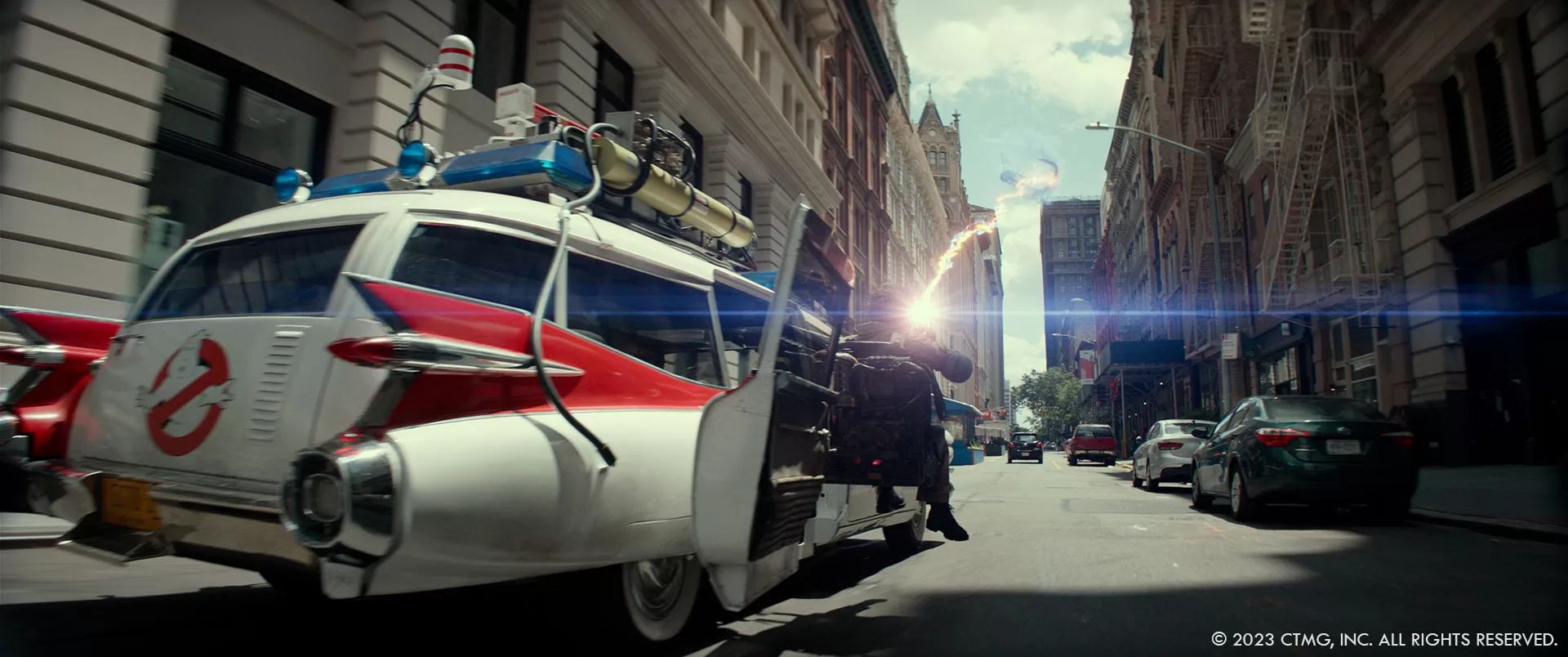
Tricky question, what is your favorite shot or sequence?
I think I would need to say I enjoyed the film as a whole. Each piece was an attempt to pay tribute to Special/Visual effects of years passed while still adhering to the direction and storytelling Gil was giving us.
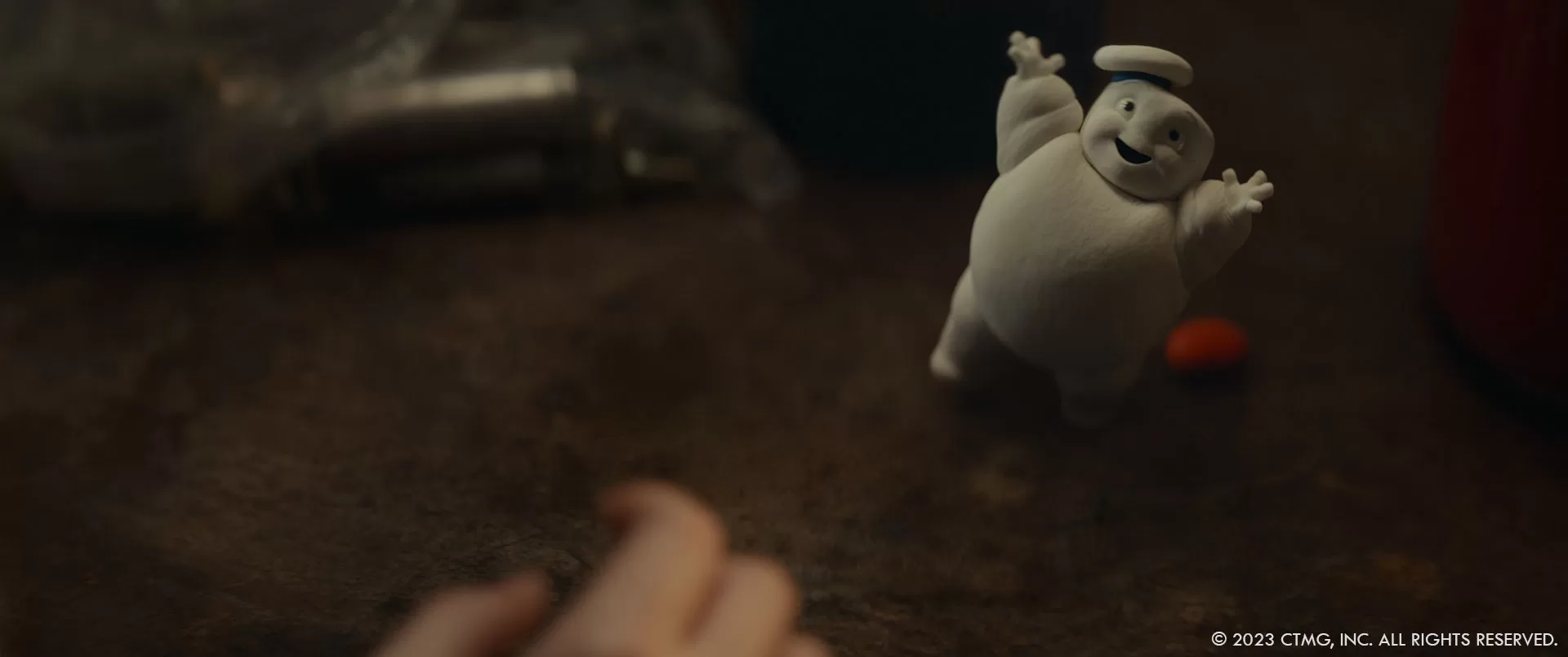
How long have you worked on this show?
I worked on the show for 1 year.
What’s the VFX shots count?
Just over 1400.
What is your next project?
Not sure just yet. Taking a break for a minute before jumping on to the next adventure.
A big thanks for your time.
WANT TO KNOW MORE?
Sony Pictures Imageworks: Dedicated page about Ghostbusters: Frozen Empire on Sony Pictures Imageworks website.
DNEG: Dedicated page about Ghostbusters: Frozen Empire on Sony Pictures DNEG website.
Territory Studio: Dedicated page about Ghostbusters: Frozen Empire on Territory Studio website.
© Vincent Frei – The Art of VFX – 2024




